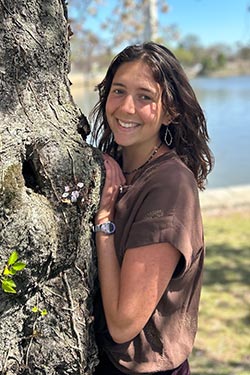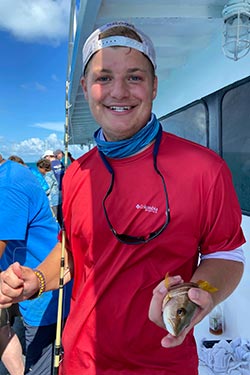Undergraduate Research Opportunities Program
About UROP | FAQs | Funded Projects | Application | Contact
Funded Projects: 2023
Miranda Buckheit, Loyola University
Advisor: Frank Jordan
Continued Assessment of Early Invasion Dynamics of Asian Swamp Eel in Lake Pontchartrain Estuary
Cuchia, an invasive Asian swamp eel, was discovered recently in Bayou St. John. They are opportune predators that can breathe air, crawl from waterbody to waterbody, burrow, inhabit dense vegetation, tolerate fresh and brackish water, all while feeding on shrimp, crabs, insect and small fishes. The primary objective of this project is to quantify the distribution and abundance of Chchia within Bayou St. John and nearby locations in Lake Pontchartrain. The research team hopes their work will provide insight toward aggressive management of this species.

 Rayna Carner and Kayla Willis, Tulane University
Rayna Carner and Kayla Willis, Tulane University
Advisor: Torbjorn Tornqvist
Carbon Accumulation in the Lafourche Delta Lobe: Towards Understanding the Potential of Sediment Diversions as Carbon Sinks
Coastal environments sequester organic carbon at high rates, with organic carbon burial rates being well-constrained for wetlands but less so for deltaic deposits like those formed from sediment diversions, such as the Mid-Barataria Diversion Project. This project will help determine the potential of the Mid-Barataria Diversion as a carbon sink by analyzing sediment cores taken near the diversion site.

 Marissa Catalanotto and Kevin Quinet, Louisiana State University (LSU)
Marissa Catalanotto and Kevin Quinet, Louisiana State University (LSU)
Advisor: Theresa Davenport
Isolating the Structural Preferences of Blue Crabs to Advance Habitat Restoration and Conservation under Changing Environmental Conditions
As a multimillion-dollar industry, blue crabs are a significant contributor to Louisiana’s economy. Blue crabs rely on a variety of habitats to thrive and reproduce. This project seeks to determine blue crab habitat preference – oyster shell reef vs. submerged aquatic vegetation – at various salinities to help fill a data gap that can help inform restoration to support the fishery under changing environmental conditions. Additionally, the project will help determine if habitat preferences are likely to change under different salinity regimes, such as those caused by freshwater diversions.

 Rohan Durgum and Jamar Whitfield, LSU
Rohan Durgum and Jamar Whitfield, LSU
Advisor: Romain Lavaud
Developing an Open-hardware Oyster Behavior Monitoring System
Traditional on-bottom oyster production yields high numbers of product, but output can be highly cyclical and subject to predation, salinity changes or poor reproduction. Alternative oyster culture can help mitigate the variables of one-bottom culture, but the use of floating cages and longline bags to grow the bivalve is underutilized. Oyster farmers currently lack a convenient, inexpensive tool to determine how oysters are performing during grow-out. The goal of this research is to design, test and eventually produce a low-cost, open-source valve opening behavior data collection system that monitors oysters during their development in both on-bottom and alternative culture techniques to improve the productivity of oyster aquaculture.
Daniel Harris, Louisiana State University
Advisor: Jerrod Penn
Understanding the Effects of Tactile Marketing on Preferences for Alligator Hide
The last several years has seen a shift in the price of American alligator hides, with wild-caught hide demand and pricing dropping and farm-raised hides being favored. Consequently, lower prices for wild-caught hides reduce incentives for hunters to harvest wild alligators, resulting in changes to the state’s ecosystem. This project’s objective is to determine if an in-person, tactile experience with a wild-caught alligator hide increases a crafts market consumer’s desire to purchase the hide versus an online experience. The research team believes a better understanding of the true value of wild-caught alligator hides will bolster the wild-caught hide market while helping with the state’s wild alligator management program.
 Ethan Horn, University of Louisiana at Lafayette
Ethan Horn, University of Louisiana at Lafayette
Advisor: Kelly Robinson
Testing the Effectiveness of Invasive Asian Carp as Crawfish Bait Relative to Natural and Artificial Baits at Winter Water Temperatures
Louisiana crawfish are fished using baited traps. Fishermen have the option to use natural fish bait, such as menhaden or shad, or artificial pellet bait. However, both baits can vary in availability and price by season. This project will look at whether raw invasive Asian carp pieces are an effective crawfish bait during winter when natural fish bait is less abundant and compare Asian carp bait efficacy compared to established natural and artificial baits.
 Emalee Swisshelm, University of New Orleans
Emalee Swisshelm, University of New Orleans
Advisor: T. Erin Cox
Trace Element Pollutants in Tissues of Fishes at Artificial Reefs in the Northern Gulf of Mexico: Are Recreational Anglers at risk from Seafood Consumption?
Many fish species rely on artificial reefs for refuge and foraging. These species, popular commercially and recreationally, may be exposed to trace element pollutants (TEPs) that can accumulate in their tissue and then be transferred to humans when eaten. Additionally, ecosystem around these artificial reefs in the Northern Gulf of Mexico may be exposed to TEPs from a variety of waste producers, transported by the Mississippi River and other tributaries. This project will focus on the amount of TEP concentrations in the tissues of 14 common fish species around artificial reefs. This project hopes to provide an analysis of the risk anglers face from harmful TEPs when consuming their catch.
